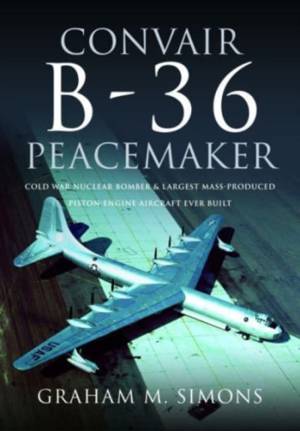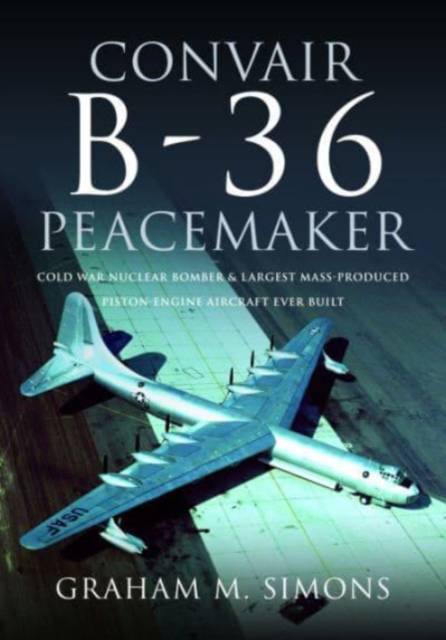
- Retrait gratuit dans votre magasin Club
- 7.000.000 titres dans notre catalogue
- Payer en toute sécurité
- Toujours un magasin près de chez vous
- Retrait gratuit dans votre magasin Club
- 7.000.0000 titres dans notre catalogue
- Payer en toute sécurité
- Toujours un magasin près de chez vous
Convair B-36 Peacemaker
Cold War Nuclear Bomber and Largest Mass-Produced Piston-Engine Aircraft Ever Built
Graham M Simons
Livre relié | Anglais
44,95 €
+ 89 points
Description
The B-36 Peacemaker, a Cold War icon, was America's first intercontinental nuclear bomber with unmatched range and technological innovation.
The story of the Consolidated B-36 is unique in American aviation history. The aircraft was an interesting blend of concepts proven during the Second World War combined with budding 1950s high-tech systems. The program survived near-cancellation on six separate occasions during an extremely protracted development process. It was also the symbol of a bitter inter-service rivalry between the newly-formed US Air Force and the well-established US Navy over which of which of the two organizations would control the delivery of atomic weapons during the early years of the Cold War.
Entering service in 1948, the B-36 was a remarkable design. It was the largest mass-produced piston-engine aircraft ever built, having the longest wingspan of any combat aircraft in history. Importantly, in terms of the developing Cold War at least, the B-36 was the first bomber capable of delivering any of the weapons in America's nuclear arsenal without modification. To achieve this part of its role, the Peacemaker had an operational range of 10,000 miles, being capable of intercontinental flight without refueling.
It is difficult to imagine a modern aircraft remaining airborne for two days without refueling - but such missions were relatively routine for the B-36 crews. while there were, at the time of its service, questions around its flight speed, the Peacemaker flew so high that this was considered of little concern - few fighters of its era could reach the same altitudes, and operational surface-to-air missiles were still in the future.
The B-36, despite its seemingly conventional appearance, pushed the state-of-the-art technology further than any other aircraft of its era. Its sheer size brought with it structural challenges, while its high-altitude capabilities led to engine cooling and associated problems. However, all of these were finally overcome, and the B-36 served well as the first 'Big Stick' of the Cold War.
The story of the Consolidated B-36 is unique in American aviation history. The aircraft was an interesting blend of concepts proven during the Second World War combined with budding 1950s high-tech systems. The program survived near-cancellation on six separate occasions during an extremely protracted development process. It was also the symbol of a bitter inter-service rivalry between the newly-formed US Air Force and the well-established US Navy over which of which of the two organizations would control the delivery of atomic weapons during the early years of the Cold War.
Entering service in 1948, the B-36 was a remarkable design. It was the largest mass-produced piston-engine aircraft ever built, having the longest wingspan of any combat aircraft in history. Importantly, in terms of the developing Cold War at least, the B-36 was the first bomber capable of delivering any of the weapons in America's nuclear arsenal without modification. To achieve this part of its role, the Peacemaker had an operational range of 10,000 miles, being capable of intercontinental flight without refueling.
It is difficult to imagine a modern aircraft remaining airborne for two days without refueling - but such missions were relatively routine for the B-36 crews. while there were, at the time of its service, questions around its flight speed, the Peacemaker flew so high that this was considered of little concern - few fighters of its era could reach the same altitudes, and operational surface-to-air missiles were still in the future.
The B-36, despite its seemingly conventional appearance, pushed the state-of-the-art technology further than any other aircraft of its era. Its sheer size brought with it structural challenges, while its high-altitude capabilities led to engine cooling and associated problems. However, all of these were finally overcome, and the B-36 served well as the first 'Big Stick' of the Cold War.
Spécifications
Parties prenantes
- Auteur(s) :
- Editeur:
Contenu
- Nombre de pages :
- 304
- Langue:
- Anglais
Caractéristiques
- EAN:
- 9781526787316
- Date de parution :
- 16-01-25
- Format:
- Livre relié
- Format numérique:
- Genaaid
- Dimensions :
- 175 mm x 249 mm
- Poids :
- 979 g

Les avis
Nous publions uniquement les avis qui respectent les conditions requises. Consultez nos conditions pour les avis.






